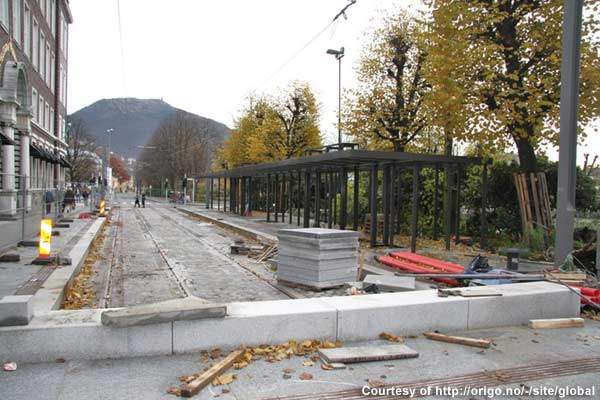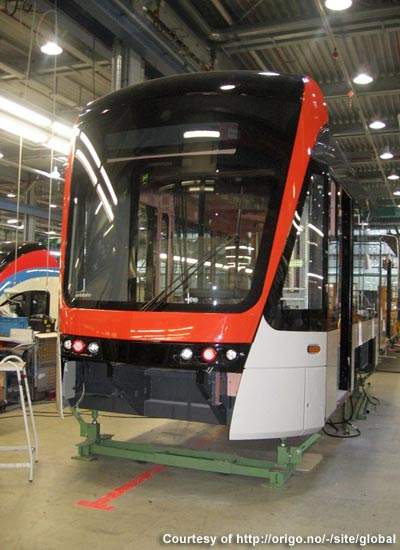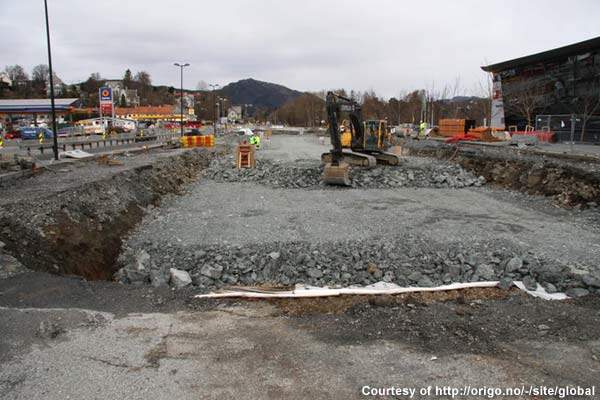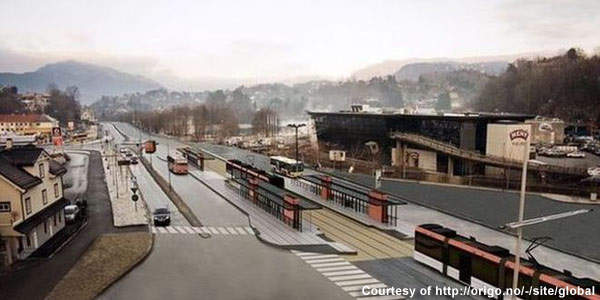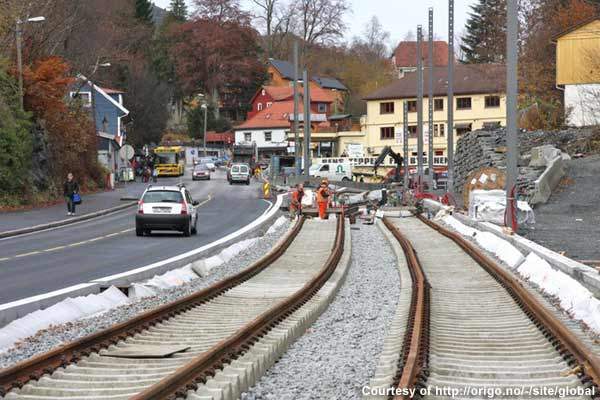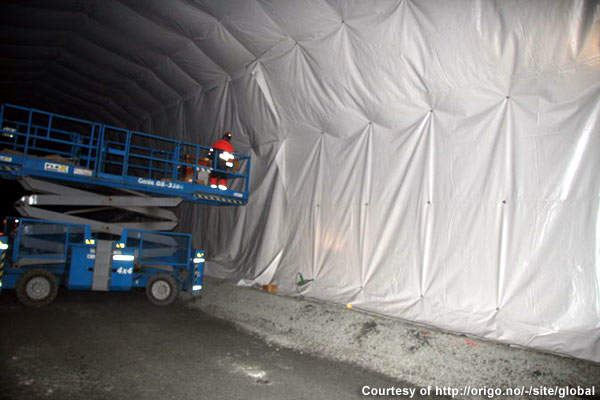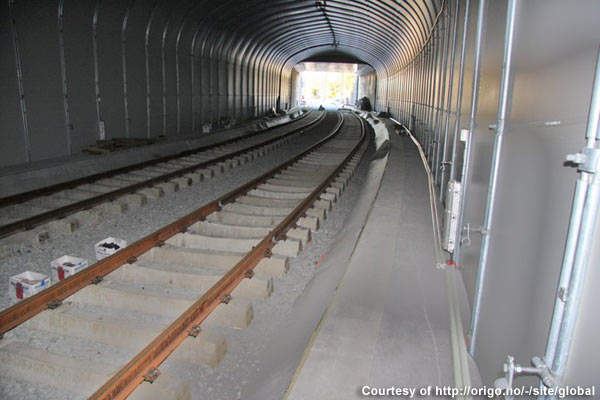The city of Bergen, Norway, is building a light rail system between the centre of the city and Bergen Airport at Flesland. The project, being undertaken in three phases, includes approximately 20km of tracks.
With a length of 9.8km and 15 intermediate stops, the first phase has been completed at an estimated investment of €175m. Roughly 3.6km will be added in the second phase and another 7km in the third phase.
The first phase of the project, which included construction of the first line from Starvhusgaten in the city centre to Nesttun, started in January 2008. This section of the project was opened for commercial business in June 2010.
The construction of the second phase from Nesttun to Rådal began in January 2011 and was completed in June 2013. This line has five stops. In the third phase, the line will be extended from Rådal to the Bergen Airport at Flesland, and from Kronstad to Fyllingsdalen.
Bergen is the second largest city in Norway and has a population of approximately 260,000 people. Most of the city’s population is concentrated in the valleys that spread outwards from the city centre.
The new light rail system is expected to enhance the efficiency of the transportation system in Bergen and provide an alternative to car travel. It is also expected to promote regional development.
Light rail system details
Due to Bergen’s relatively small size, the government previously focused on encouraging private automobile transport rather than developing a public transport system. Over the years, traffic volumes increased dramatically, leading to traffic jams and accidents.
The increase in the number of car users also raised environmental concerns. The light rail system was proposed to address these issues.
A light rail system was proposed in 2000 and approved in 2002. The project is being financed by Bergen Municipality, Hordaland County Council and the state and citizens of Bergen through tolls. Norway-based consulting engineering company Norconsult was awarded the contract for design, construction procurement strategy, and technical specifications for infrastructure and tender documents.
The project will serve 25% of the city’s population, with the existing bus services providing feeder services. Major stations on the light rail system will include parking facilities to encourage a park and ride system.
The first section of the light rail system is being operated by Fjord1 Partner, a joint venture between transport company Fjord1 Nordvestlandske and French transport group Keolis. The joint venture will operate this line until 2017.
The average operating speed of the system is about 25km/h to 30km/h. There is an express service during peak hours and a faster service between major stations and terminals. Trains operate on 5min headways in each direction during peak traffic periods and 10min headways during off-peak periods.
Infrastructure of Bergen’s public transport project
The initial portion of the 10km railway section features four tunnels with a total length of 2.5km. The tunnels do not have stations due to the high costs involved.
During the first phase of the system, 15 stations were built. The stations are located at street level and feature public display systems and ticketing facilities. The station platforms are 40m to 45m-long and provide step-free access to trams. The platforms are accessible by wheelchairs and strollers.
The contract for designing the stations was awarded in June 2006 to a group consisting of Cubus, Fuggi Baggi Design, clothing designer T Michael and Kontragroup of Copenhagen. The contract included landscape architecture, design of stations and interiors of trams, industrial design and branding.
The project features an integrated smart-card ticketing system with a one-ticket ride for all transport services. A real-time information system was installed at all stations. The system provides information about travel time, arrival time of incoming trains and the station.
The contract for designing the 3.6km-long double track line was awarded to Atkins. The double track line connects Bergen city centre to the Radal outskirt community. In September 2012, Mott MacDonald received a contract from Bybanen to provide detailed design services for a €90m workshop and depot of the light rail system.
Sweco signed a contract worth approximately $22m to provide tunnel engineering, signals and landscape designing for the new tunnel section of the Bergen light rail system.
DANOBAT is responsible for supplying the train shunt measuring system for the third phase of the project.
Rolling stock to run on the new light rail system
In May 2007 the city of Bergen and Stadler Pankow, a Swiss rail passenger cars manufacturer, signed a contract for the supply of 12 low-floor light-rail vehicles with an option for another five. Four trams were delivered before the opening of the line.
The bi-directional vehicles can travel at 70km/h. They are 32m-long and 2.65m-wide. They can carry 220 passengers and can be extended to 42m to carry more than 300 passengers.
They feature ergonomically designed driver cabins at either end. The gauges are 1,435mm but can be operated on 1,000mm. Each vehicle has four exterior double-wing sliding doors on either side.
The exterior body of the vehicles is made from stainless-steel and is built with bounding technology, which ensures exteriors can be changed easily after accidents.
Signalling and communication systems
In September 2008, Thales was awarded the contract to supply telecommunications, traffic priority and traffic control and supervision systems for the project. Thales provided rail signalling, video surveillance and information systems for the first phase.
Thales partnered with a Scandinavian company YIT and Hanning and Kahl of Germany to deliver the project. YIT provided telecommunications infrastructure and on-site commissioning, while Hanning and Kahl supplied signalling equipment.
Thales partnered with BelAir Networks to install onboard and trackside Wi-Fi infrastructure. The Wi-Fi network includes 40 BelAir100 nodes along the entire length of the tram network.
The new train cars are fitted with BelAir Networks’ BelAir20M mobile access points to provide 802.11n/b/g Wi-Fi access for smartphones such as iPhones, laptops and Wi-Fi enabled devices.
Future for Norway’s second largest city’s multiphase light rail system project
Bergen is drawing up plans for future extension of the light railway system. It will be extended to Fyllingsdalen and Loddefjord in the west and Sandviken / Åsane in the north. A link between the primary regional hospital and the city centre is also being considered.

